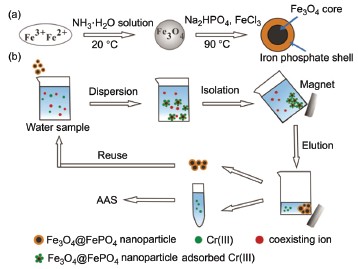| [1] Liu, Y.-Y.; Su, G.-X.; Zhang, B.; Jiang, G.-B.; Yan, B. Analyst 2011, 136, 872.[2] Wang, J.-L.; Liu, G.-H.; Zhang, X.-R. Chin. J. Anal. Chem. 2005, 33(12), 1787. (王璟琳, 刘国宏, 张新荣, 分析化学, 2005, 33(12), 1787.)[3] Wang, H.-Y.; Andres, D. C. Anal. Chem. 2008, 80(21), 8202.[4] Benjamin, N. Y. V; Gang, H.; Vincent, M. R.; Richard, W. V. Anal. Chem. 2006, 78(15), 5491.[5] Wu, S.-X.; Xing, Z.; Chen, H.-B.; Wang, J.; Feng, L. Chin. J. Anal. Chem. 2009, 37(5), 711. (吴少雄, 邢志, 陈红兵, 王娟, 冯璐, 分析化学, 2009, 37(5), 711.)[6] Zhao, Y.-G.; Shen, H.-Y.; Li, Q.; Xia, Q.-H. Acta Chim. Sinica 2009, 67, 1509. (赵永纲, 沈昊宇, 李勍, 夏清华, 化学学报, 2009, 67, 1509.)[7] Chai, D.-L.; Chu, Z.-B.; Yang, B.-J.; Zhang, N. J. Chin. Ceram. Soc. 2011, 39(3), 419.[8] Li, K.-B.; Wang, Q.-Q.; Dang, Y.; Wei, H.; Luo, Q.; Zhao, F. Acta Chim. Sinica 2012, 70, 929. (李克斌, 王勤勤, 党艳, 魏红, 罗倩, 赵锋, 化学学报, 2012, 70, 929.)[9] Zhang, X.-L.; Niu, H.-Y.; Pan, Y.-Y.; Shi, Y.-L.; Cai, Y.-Q. Anal. Chem. 2010, 82(6), 2363. [10] Zhang, S.-X.; Niu, H.-Y.; Hu, Z.-J.; Cai, Y.-Q.; Shi, Y.-L. J. Chromatogr. A 2010, 1217, 4757.[11] Chang, Y.-C.; Chen, D.-H. J. Colloid Interface Sci. 2005, 283, 446.[12] Liu, J.-F.; Zhao, Z.-S.; Jang, G.-B. Environ. Sci. Technol. 2008, 42(18), 6949.[13] Mesko, M. G.; Day, D. E.; Bunker, B. C. Waste Manage. 2000, 20, 271.[14] Lazzarin, P.; Bellemo, S. Lamiera 1989, 26, 116.[15] Yu, D.-H.; Qian, J.-S.; Xue, N.-H.; Zhang, D.-Y.; Wang, C.-Y.; Guo, X.-F.; Ding, W.-P.; Chen, Y. Langmuir 2007, 23, 382.[16] Zhang, X.-X.; Tang, S.-S.; Chen, M.-L.; Wang, J.-H. J. Anal. At. Spectrom. 2012, 27, 466.[17] Martin, F.; Roger, N.; Ian, J. L.; John, F.; Eileen, I.; Charles, P. C. Mutat. Res. Fundam. Mol. Mech. Mutagen. 2010, 688, 53.
[18] Eastmond, D. A.; MacGregor, J. T.; Slesinski, R. S. Crit. Rev. Toxicol. 2008, 38, 173.[19] Ren, C.-L.; Li, J.-H.; Chen, X.-G.; Hu, Z.-D.; Xue, D.-S. Nanotechnology 2007, 18, 345604. |
